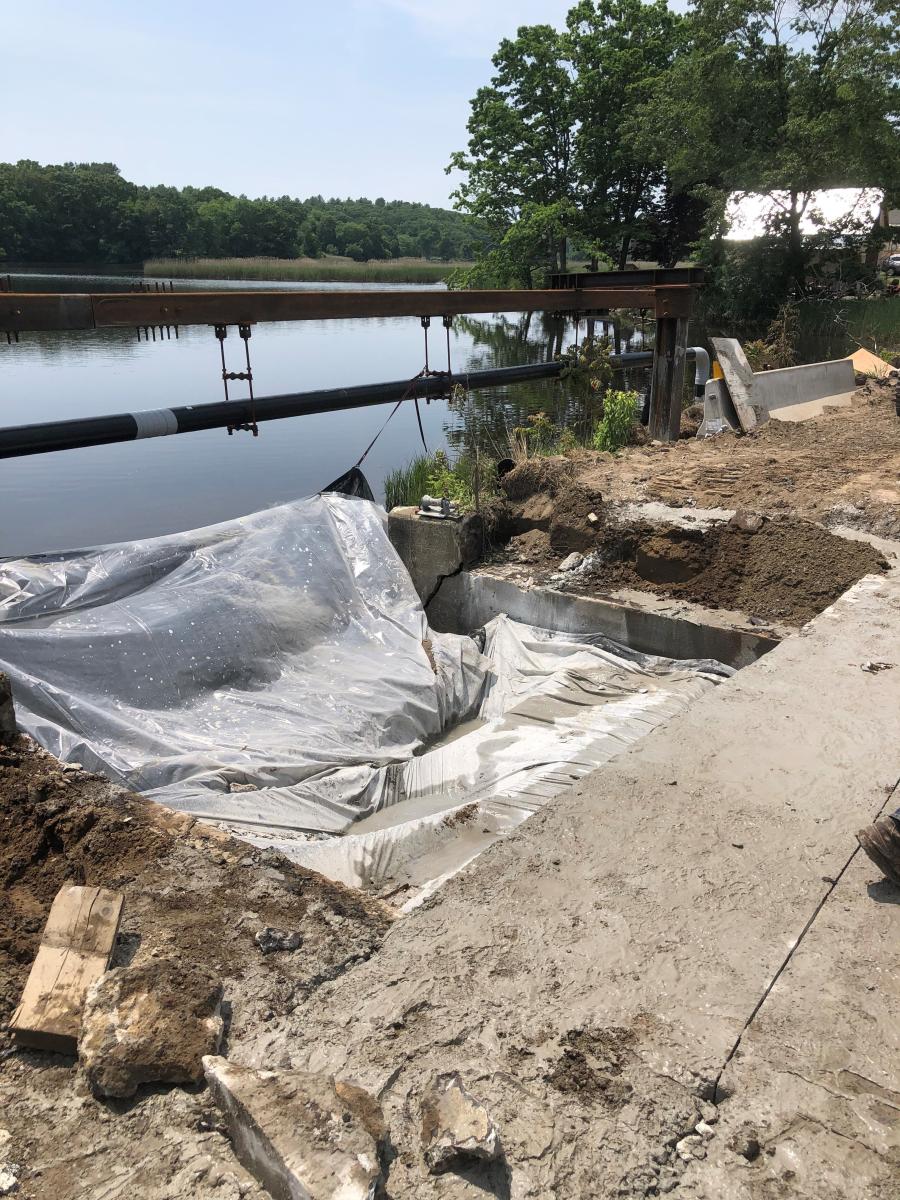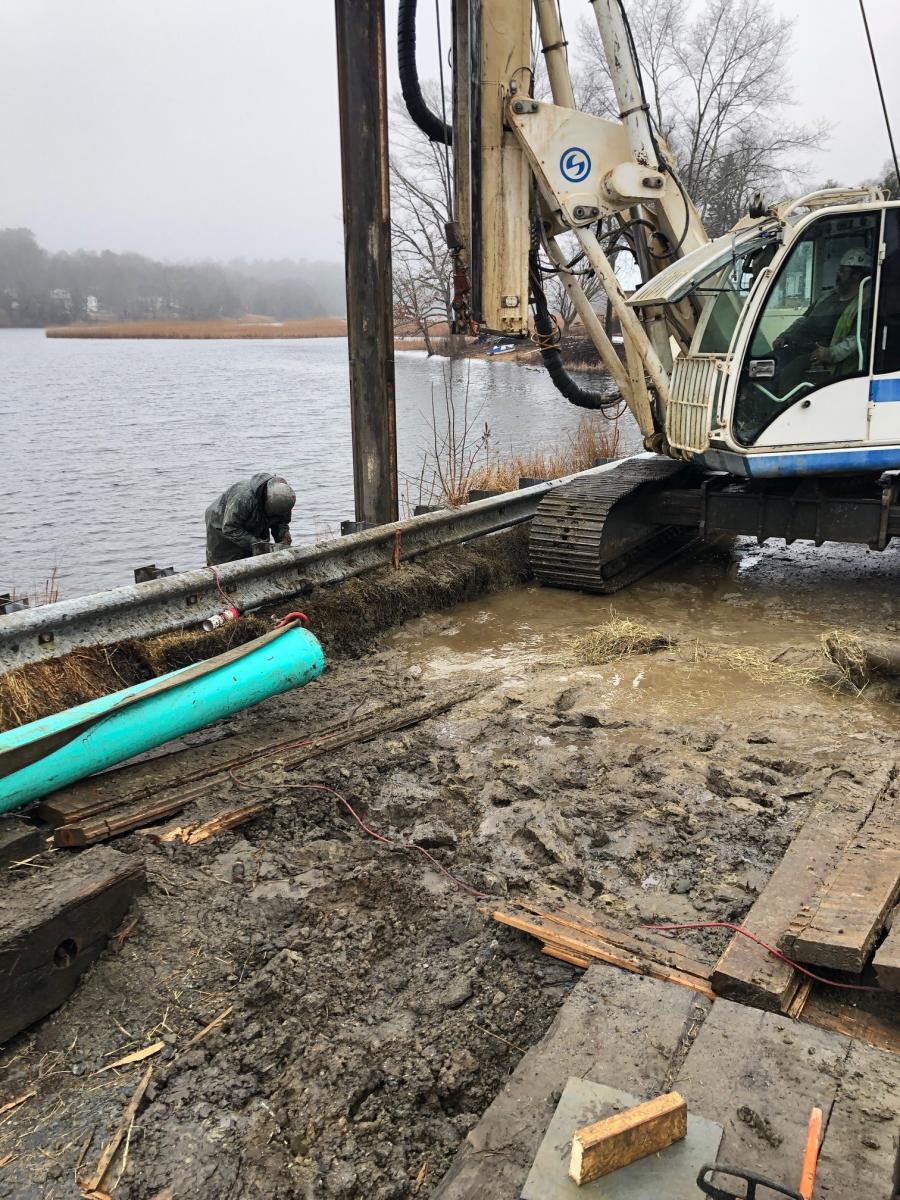As Stage 1 bridge superstructure demolition ensues, the demolition subcontractor slings up the parapet for removal, prior to breaking up and loading onto its dump trailer for relocation to the recycling facility.
(Andrew Millovitsch/CTDOT photo)
In Connecticut, work has begun on the rehabilitation of two bridges on Route 2A in Preston. The Connecticut Department of Transportation (CTDOT) is overseeing activities on Bridge 02931 carrying Route 2A over Poquetanuck Cove and Bridge 02932 carrying Route 2A over Halsey Brook.
"Bridge inspections by the department yielded a poor bridge rating for each structure, which requires addressing for safe travel of the public and long-term longevity and cost effectiveness of the structures," said Andrew "Millo" Millovitsch, CTDOT project engineer. The bridges serve all traffic traveling US Route 2A, as well as traffic to and from both Foxwoods and Mohegan Sun casinos."
The average daily traffic (ADT) for this section of roadway is roughly 11,000 vehicles per day. The work involves the complete removal and replacement of bridge superstructures with pre-stressed concrete deck slabs. The substructure abutments will undergo extensive repairs.
A key part of the job has involved major utility coordination, including maintaining bridge-mounted electrical utilities, while also maintaining and relocating a 12-in. gas main. Millovitsch said a significant amount of research and planning was necessary to bring the project to fruition.
"This involved inspections of both structures, to determine what extent of rehabilitation was required, as well as determination of an engineer of record for each."
The typical design phase, where the entire scope of work is fine-tuned and determined, includes geotechnical investigations of surrounding soil and environment. Traffic studies were also necessary, as well as a review of the handling of overhead and underground utilities prior to, during and after construction.
When dealing with a project of this nature, Millovitsch said the safety of the traveling public passing through the staged workzone on a daily basis is a chief concern, as well as the safety of pedestrians, inspection staff overseeing the work and the laborers on site each day.
"Currently, the gas main relocation subcontractor has about a four- to five-man crew. Crew sizes for all other contractors will fluctuate, as required by the schedule. It constantly evolves and changes."
Workers are still in the early stages of rehabilitating the structures. Construction includes bridge deck demolition, bridge seat reconstruction, abutment and wingwall rehab, precast beams and closure pours to gain new bridge decks, membrane waterproofing, hot mix asphalt placement, metal beam rail improvements, curbing and line striping.
Regarding dirt work, "Careful excavation must be practiced on this project, due to the sensitivity of the soils and water course environment," said Millovitsch. "All excavated material will be reused on site, if possible. Imported lightweight fill will also be utilized behind structures to alleviate soil loading on the rehabbed structure. New subbase will be utilized in the new roadway boxout structure beneath HMA."
An estimated 3,500 cu. yds. of dirt/material will be moved during construction, although the number could change. As for the complete removal and replacement of bridge superstructures with pre-stressed concrete deck slabs, careful demolition and disposal of existing superstructure is required.
Specifically, the work calls for dialed-in bridge seat and bearing pad construction, shop drawing and fabrication process in the plant of the precast pre-stressed beams, methodical shipment to the job site and careful erection/placement of the beams at each bridge. Construction also calls for cast-in-place (CIP) closure pours and ancillary bridge components, with membrane waterproofing and HMA wearing surface placed for final deck protection.
Substructure elements will be prepared to accept and will be reinforced with a 4-in. layer of Ultra High Performance Concrete (UHPC). This UHPC is impermeable, protecting the existing structure from infiltration and deterioration caused by salt water and any other contaminants that may exist in the waterways.
During construction, the profile of Bridge 02932 over Halsey Brook will be raised roughly 21 in.
This requires reconstruction of the bridge seat and surrounding roadway to new elevations. This means additional CIP concrete for seat, and extra subbase material in roadway to achieve gentle transitions as cross sections depict.
Utility work has involved overhead utility relocation prior to construction, and relocation back to original/final locations. Temporary support of the 12-in. gas main and HPFF lines during construction was deemed necessary, along with final attachment to the new structures. Relocating the 12-in. gas main means temporarily reducing to 8-in. main across the structures, being supported on temporary pin piles and steel support system and final restoration of 12-in. main attached to rehabbed wingwalls.
Stage two of the work will occur in July. Crews will re-open the roadway to two-way traffic by Nov. 30, 2020.
Demolition recently began on the project. Demo by mechanical means requires precision with equipment and the workforce. Measures were put in place to protect the waterway with debris shields and other environmental protection equipment/material. Cleanup efforts are a top priority throughout the demo process. All concrete and steel debris will be disposed of and/or recycled at an approved disposal facility.
Excavators will be the main equipment used on the job. Other heavy machinery includes triaxle dump trucks to move and deliver earth material, and flatbed tractor trailers to move and deliver heavy machinery and concrete barrier and beams.
A Doosan DX190 rubber-tired excavator and a Doosan DX180 excavator will be off-loading and erecting the precast deck beams. The demo subcontractor is using a Cat 329F excavator with a MSD2000 member shear grapple attachment for picking up concrete rubble pieces of the existing bridge deck.
Demolition of the superstructures will be the most time-consuming part of the work, based on protection of the environment measures, establishment of new bridge seats, lining of the abutments and wingwalls due to formwork erection and placement of the UHPC and establishment of the new bridge decks.
Main materials required on the project include class ‘F' and ‘A' concrete, UHPC, subbase and lightweight fill. Processed aggregate base is also needed, along with pervious structure backfill and streambed material, if supplemental material is required.
In January 2020, the project was awarded to New England Infrastructure Inc., a multi-disciplined heavy/civil contractor that specializes in providing engineered solutions to complex assignments. Although much work remains for the crews on site, Millovitsch said it's extremely gratifying to see work progressing.
"Anytime the department is working to improve and maintain our infrastructure, and doing that job as productively, efficiently and cost-effectively as possible, even on jobs that might not seem that glamorous, it's rewarding for me. I get a strong sense of satisfaction from the accomplishment, and knowing that we are doing the very best we can for the public we serve. It will mean safer roads and bridges to traverse, and we won't have to be out to address any major issues with these structures for many years to come."
The project, a combination of state and federal funding, should be completed by spring of next year. CEG
Today's top stories


















